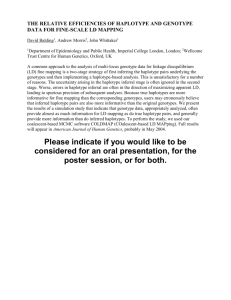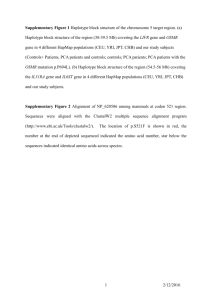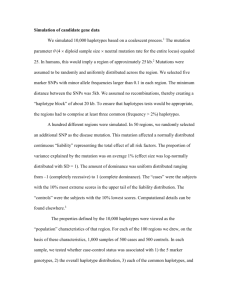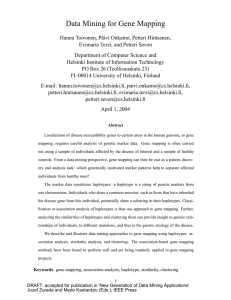Ohio State Talk, October 2004 - Department of Statistics
advertisement
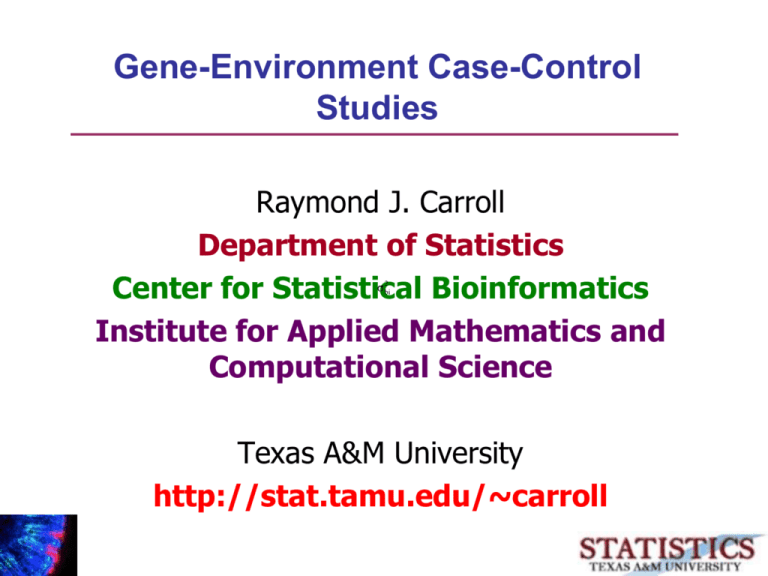
Gene-Environment Case-Control
Studies
Raymond J. Carroll
Department of Statistics
σ
Center for Statistical
Bioinformatics
Institute for Applied Mathematics and
Computational Science
2
bi
Texas A&M University
http://stat.tamu.edu/~carroll
Note the Maroon color scheme! And the green MSU flag.
Apologies to Dr. Seuss
Michigan State Grads at TAMU
Mohsen Pourahmadi
Soumen Lahiri
Other Michigan State Contacts
David Ruppert
Anton Schick
Outline
• Problem: Case-Control Studies with GeneEnvironment relationships
• Theme I: Logistic regression is lousy for
understanding interactions. We make
assumptions that can double or triple the
effective sample size
Outline
• Problem: Case-Control Studies with GeneEnvironment relationships
• Theme II: There is a lousy estimator, and a
good one that makes more assumptions. How
do you protect yourself if the assumptions fail,
and you want to analyze 500,00 SNP?
Outline
• Problem: Case-Control Studies with GeneEnvironment relationships
• Theme III: How does all this work with actual
data, as opposed to simulated data?
Software
• SAS and Matlab Programs Available at my web
site under the software button
http://stat.tamu.edu/~carroll
• R programs available from the NCI
• New Statistical Science paper 2009, volume 24,
489-502
Basic Problem Formalized
• Gene and Environment
• Question: For women who carry the BRCA1/2
mutation, does oral contraceptive use
provide any protection against ovarian cancer?
Basic Problem Formalized
• Gene and Environment
• Question: For people carrying a particular
haplotype in the VDR pathway, does higher
levels of serum Vitamin D protect against
prostate cancer?
Basic Problem Formalized
• Gene and Environment
• Question: If you are a current smoker, are
you protected against colorectal adenoma if you
carry a particular haplotype in the NAT2
smoking metabolism region?
Retrospective Studies
• D = disease status (binary)
• X = environmental variables
• Smoking status
• Vitamin D
• Oral contraceptive use
• G = gene status
• Mutation or not
• Multiple or single SNP
• Haplotypes
Prospective and Retrospective Studies
• Retrospective Studies: Usually called casecontrol studies
• Find a population of cases, i.e., people with a
disease, and sample from it.
• Find a population of controls, i.e., people
without the disease, and sample from it.
Prospective and Retrospective Studies
• Retrospective Studies: Because the gene G
and the environment X are sample after
disease status is ascertained
Basic Problem Formalized
• Case control sample: D = disease
• Gene expression: G
• Environment, can include strata: X
• We are interested in main effects for G and X
along with their interaction as they affect
development of disease
Logistic Regression
• Logistic Function:
1
H(x)
1 exp( x)
exp(x)
• The approximation works for rare diseases
Prospective Models
• Simplest logistic model without an interaction
pr(D 1|G, X) H( 0 1G 2 X)
• The effect of having a mutation (G=1) versus not
(G=0) is
pr(D 1| G 1, X)
exp(1 )
pr(D 1| G 0 , X)
Prospective Models
• Simplest logistic model with an interaction
pr(D 1|G, X) H( 0 1G 2 X 3G * X)
• The effect of having a mutation (G=1) versus not
(G=0) is
pr(D 1| G 1, X)
exp(1 3 X)
pr(D 1| G 0, X)
Empirical Observations
• Statistical Theory: There is a lovely statistical
theory available
• It says: ignore the fact that you have a casecontrol sample, and pretend you have a
prospective study
When G is observed
• Logistic regression is robust to any modeling
assumptions about the covariates in the
population
• Unfortunately it is not very efficient for
understanding interactions
• Much larger sample sizes are required for
interactions that for just gene effects
Gene-Environment Independence
• In many situations, it may be reasonable to
assume G and X are independently distributed in
the underlying population, possibly after
conditioning on strata
• This assumption is often used in geneenvironment interaction studies
G-E Independence
• Does not always hold!
• Example: polymorphisms in the smoking
metabolism pathway may affect the degree of
addiction
Gene-Environment Independence
• If you are willing to make assumptions about
the distributions of the covariates in the
population, more efficiency can be obtained.
• This is NOT TRUE for prospective studies, only
true for retrospective studies.
Gene-Environment Independence
• The reason is that you are putting a constraint on
the retrospective likelihood
pr (X = x ; G = gjD = d)
pr (X = x ; G = g)
=
pr (D = djX = x ; G = g)
pr (D = d)
pr (X = x )pr (G = g)
=
pr (D = djX = x ; G = g)
pr (D = d)
Gene-Environment Independence
• Our Methodology: Is far more general than
assuming that genetic status and environment
are independent
• We have developed capacity for modeling the
distribution of genetic status given strata
and environmental factors
• I will skip this and just pretend G-E independence
here
More Efficiency, G Observed
• Our model: G-E independence and a genetic
model, e.g., Hardy-Weinberg Equilibrium
pr(G g) q(g|θ)
The Formulation
• Any logistic model works
pr(D 1|G, X) Hβ0 m(G, X, β1 ) ,
pr(G g) q(g| θ)
X Nonparametric,multi dimensional
• Question: What methods do we have to
construct estimators?
Methodology
• I won’t give you the full methodology, but it
works as follows.
• Case-control studies are very close to a
prospective (random sampling) study, with the
exception that sometimes you do not observe
people
Methodology
N
Total Population
Cases in the
Population
Np1
Cases in the
Sample
n1
n0
Np1
n1
Np0
n0
Missing
Cases
% of Cases
observed
n1
Nπ1
Np0
n0
Nπ 0
Controls in the
Population
Controls in the
Sample
Missing
Controls
% of Controls
observed
Pretend Missing Data Formulation
• This means that there is a missing data problem.
• The selection into the case control study is
biased: cases are vastly over-represented
• Ordinary logistic regression computes the
probability of disease given the environment,
given the gene, and given that the person
was selected into the case control study
Pretend Missing Data Formulation
• This means that there is a missing data problem.
• Our method computes the probability of disease
and the probability of gene given the
environment and given that the person was
selected into the case control study
• The selection into the case control study is
biased: cases are vastly over-represented
Methodology
• Our method has an explicit form, i.e., no
integrals or anything nasty
• It is easy to program the method to estimate
the logistic model
• It is likelihood based. Technically, a
semiparametric profile likelihood
Methodology
• We can handle missing gene data
• We can handle error in genotyping
• We can handle measurement errors in
environmental variables, e.g., diet
Methodology
• Our method results in much more efficient
statistical inference
More Data
• What does More efficient statistical
inference mean?
• It means, effectively, that you have more data
• In cases that G is a simple mutation, our
method is typically equivalent to having 3
times more data
How much more data: Typical
Simulation Example
• The increase in effective sample size when
using our methodology
4
3.5
3
2.5
pr(G)=.05
pr(G)=.20
2
1.5
1
0.5
0
G
X
G times X
Real Data Complexities
• The Israeli Ovarian Cancer Study
• G = BRCA1/2 mutation (very deadly)
• X includes
• age,
• ethnic status (below),
• parity,
• oral contraceptive use
• Family history
• Smoking
• Etc.
Real Data Complexities
• In the Israeli Study, G is missing in 50% of
the controls, and 10% of the cases
• Also, among Jewish citizens, Israel has two
dominant ethnic types
• Ashkenazi (European)
• Shephardic (North African)
Real Data Complexities
• The gene mutation BRCA1/2 if frequent
among the Ashkenazi, but rare among the
Shephardic
• Thus, if one component of X is ethnic status,
then pr(G=1 | X) depends on X
• Gene-Environment independence fails
here
• What can be done? Model pr(G=1 | X) as
binary with different probabilities!
Israeli Ovarian Cancer Study
• Question: Can carriers of the BRCA1/2
mutation be protected via OC-use?
Typical Empirical Example
Israeli Ovarian Cancer Study
• Main Effect of BRCA1/2:
Israeli Ovarian Cancer Study
Haplotypes
• Haplotypes consist of what we get from our
mother and father at more than one site
• Mother gives us the haplotype hm = (Am,Bm)
• Father gives us the haplotype hf = (af,bf)
• Our diplotype is Hdip = {(Am,Bm), (af,bf)}
Haplotypes
• Unfortunately, we cannot presently observe the
two haplotypes
• We can only observe genotypes
• Thus, if we were really Hdip = {(Am,Bm), (af,bf)},
then the data we would see would simply be
the unordered set (A,a,B,b)
Missing Haplotypes
• Thus, if we were really Hdip = {(Am,Bm), (af,bf)},
then the data we would see would simply be
the unordered set (A,a,B,b)
• However, this is also consistent with a different
diplotype, namely Hdip = {(am,Bm), (Af,bf)}
• Note that the number of copies of the (a,b)
haplotype differs in these two cases
• The true diploid = haplotype pair is missing
Missing Haplotypes
• Our methods handle unphased diplotyes
(missing haplotypes) with no problem.
• Standard EM-algorithm calculations can be
used
• We assume that the haplotypes are in HWE, and
have extended to cases of non-HWE
Robustness
• Robustness: We are making assumptions to
gain efficiency = “get more data”
• What happens if the assumptions are wrong?
• Biases, incorrect conclusions, etc.
• How can we gain efficiency when it is
warranted, and yet have valid inferences?
Two Likelihoods
• The two likelihoods lead to two estimators
ˆfree ,
ˆmodel
• The former is robust but not efficient
• The latter is efficient but not robust
• What to do?
Empirical Bayes
• The idea is to take a weighted average of the
model free and model based estimators
• The weight depends on how different the
estimators are
ˆmodel
ˆfree
• Relative to how variable the difference is
ˆmodel
ˆfree )
V var(
Empirical Bayes
• You can actually formally test the hypothesis
of whether the model fits the data
• It is just a t-test on the difference between
the two estimators
Empirical Bayes
ˆmodel
ˆfree
ˆmodel
ˆfree )
V var(
• If the difference is small relative to the
variability, then this argues in favor of the
model based approach
Empirical Bayes
• We chose an Empirical Bayes type-approach
ˆEB
ˆfree Κ (
ˆmodel
ˆfree )
• Let V var(ˆmodel ˆfree ) and
• Then
K
vj
vj
2
j
ˆmodel
ˆfree
Comments on Empirical Bayes
• If the model fails, then the estimator
converges to the model-free estimator
• If the model holds, the estimator estimates
the right thing, but is much more efficient
than the model-free estimator
Example 1: Prostate Cancer
• G = SNPs in the Vitamin D Pathway
• X = Serum-level biomarker of vitamin D (diet
and sun)
• The VDR gene is downstream in the pathway,
hence unlikely to influence the level of X
• Gene-environment independence likely
Example 1: Prostate Cancer
• 3 age groups
• 9 centers
• Two haplotype-serum Vitamin D interactions
• Three haplotype main effects
Example 2: Colorectal Adenoma
• G = SNPs in the NAT2 gene, which is important
in the metabolism of
• X =Various measures of smoking history
• The NAT2 gene may make smokers more
addicted
• Gene-environment independence unlikely
Example 2: Colorectal Adenoma
• Two genders
• 4 age groups
• 7 common haplotypes as main effects
• One haplotype known to affect metabolism
• Current and former smoking interactions
The NAT2 Example
• Current smoking and 101010 haplotype
interaction coefficient
Method
Estimate s.e.
p-value
Model Free
-0.63
0.17
0.014
Independence
-0.33
0.16
0.048
Consistent EB1
-0.59
0.25
0.017
• Current smokers with this haplotype are 50%
less likely to develop a colorectal adenoma
The VDR Example
• Serum Vitamin D and 000 haplotype interaction
coefficient
Method
Estimate s.e.
p-value
Model Free
-0.21
0.12
0.093
Independence
-0.18
0.08
0.019
Consistent EB1
-0.19
0.08
0.021
• Men with 1 sd greater Serum vitamin D then
the norm are 70% less likely to develop
prostate cancer
Genome-Wide Association Studies
• These methods are routinely applied to GWAS
• My last two examples were actually from the
PLCO GWAS
• Also, can call the environment = other SNP
Summary
• Case-control studies are the backbone of
epidemiology in general, and genetic
epidemiology in particular
• Their retrospective nature distinguishes them
from random samples = prospective studies
Summary
• We start by assuming relationships between
the genes and the “environment” in the
population, e.g., independence
• This model can be fully flexible
• We also, where necessary, specify distributions
for genes
Summary
• We calculated a new likelihood function, leading
to more much more precise inferences
• The method can handle missing genes,
genotyping errors, measurement errors in
the environment
• Calculations are straightforward via the EM
algorithm
Summary
• Forced to face the dilemma
• Lousy but robust method
• Great but not robust method
• We developed a fast, data adaptive, novel way
of addressing this issue
• In cases where one can predict the outcome,
the EB method works as desired
Acknowledgments
• This work is joint with Nilanjan Chatterjee (NCI)
and Yi-Hau Chen (Academia Sinica)
Acknowledgments
• This work is supposed by
– NCI-R27-CA057030
– NHLBI RO1-HL091172 (P.I., N. Chatterjee)
– Texas A&M Institute of Applied Mathematics and
Computational Science through KAUST (King Abdullah
University of Science and Technology)

